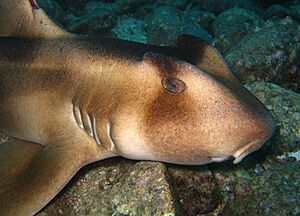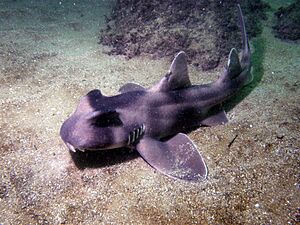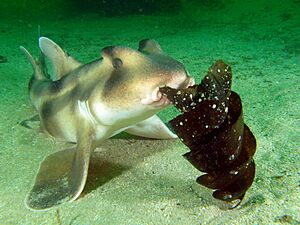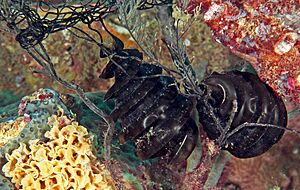Crested bullhead shark facts for kids
Quick facts for kids Crested bullhead shark |
|
|---|---|
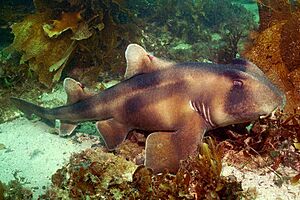 |
|
| Conservation status | |
| Scientific classification | |
| Genus: |
Heterodontus
|
| Species: |
galeatus
|
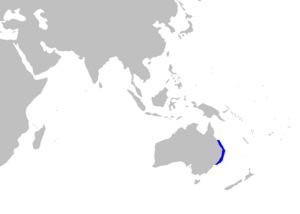 |
|
| Range of the crested bullhead shark | |
| Synonyms | |
|
Cestracion galeatus Günther, 1870 |
|
The crested bullhead shark (Heterodontus galeatus) is a special type of bullhead shark. It belongs to a family called Heterodontidae. You can find it near the coast of eastern Australia. It lives in waters up to about 93 meters (305 feet) deep.
This shark is easy to spot because of the big bumps above its eyes. It also has large dark spots on its body. It usually grows to about 1.2 meters (4 feet) long. This shark is active at night and lives near the bottom of the ocean. It likes rocky reefs and areas with lots of plants. It hunts for sea urchins and other small creatures.
Female crested bullhead sharks lay spiral-shaped egg capsules. They attach these eggs to seaweed or sponges. This shark is not considered endangered. It is also harmless to humans.
Contents
About the Crested Bullhead Shark
Naming the Shark
A British zoologist named Albert Günther first described this shark in 1870. He called it Cestracion galeatus. The name galeatus comes from a Latin word meaning "helmeted." This refers to the helmet-like ridges above the shark's eyes. These ridges also give the shark its common name.
Later, scientists moved this shark into the Heterodontus group. The first shark studied was a 68-centimeter-long female from Australia. People sometimes call this shark the crested shark or crested horn shark.
What Does It Look Like?
The crested bullhead shark has a short, wide head. Its snout looks a bit like a pig's snout. Its eyes are set high on its head. The ridges above its eyes are bigger than those of any other shark in its family.
Its nostrils have a long flap of skin that reaches its mouth. The mouth is almost at the tip of its snout. The teeth at the front are small and pointed. The teeth at the back are wide and flat, like molars.
The shark's fins are large and rounded. It has two dorsal fins (back fins) with strong spines. The tail fin is wide. Its skin feels rough because of tiny, hard scales called dermal denticles. The shark is light tan with five brown to black blotches on its back. It also has dark marks on its head and below its eyes. Most crested bullhead sharks are about 1.2 meters (4 feet) long. Some can grow up to 1.5 meters (5 feet).
Where Do They Live?
The crested bullhead shark lives in the warm waters off eastern Australia. You can find it from Cape Moreton in Queensland to Batemans Bay in New South Wales. It mostly lives on the continental shelf. This means it stays in shallower waters, from the shore down to about 93 meters (305 feet) deep. It is more common in deeper areas.
This shark likes rocky reefs, areas with lots of seaweed, and seagrass beds. It often shares its home with the related Port Jackson shark. However, the crested bullhead shark is usually rarer.
Life and Habits of the Shark
What Do They Eat?
The crested bullhead shark moves slowly and is active at night. It often pokes its head into rocks to find food. It mainly eats sea urchins. But it also eats other small invertebrates and small fishes. Eating a lot of sea urchins can even turn its teeth pinkish-purple!
This shark also loves to eat the eggs of the Port Jackson shark. These eggs are available at certain times of the year and are full of nutrients. Crested bullhead sharks have been seen biting the tough egg cases to get to the food inside. They can even swallow the whole egg case! Unlike some other sharks, crested bullhead sharks do not gather in large groups.
How Do They Reproduce?
Crested bullhead sharks lay eggs. Females lay about 10 to 16 eggs each year. This usually happens in late winter, around July and August. The egg cases are about 11 centimeters (4.3 inches) long. They have spiral ridges and two long, thin tendrils. These tendrils, which can be up to 2 meters (6.6 feet) long, help attach the egg case to seaweed or sponges.
The eggs are usually laid in water about 20 to 30 meters (66 to 98 feet) deep. It takes about 5 to 9 months for the eggs to hatch. When the young sharks emerge, they are about 17 to 22 centimeters (6.7 to 8.7 inches) long. They look like miniature versions of the adults. Males become mature when they are about 60 centimeters (24 inches) long. Females mature at about 70 centimeters (28 inches). One female shark in an aquarium did not lay eggs until she was almost 12 years old.
Crested Bullhead Sharks and Humans
Interactions with People
The crested bullhead shark is not harmful to humans. It is not a major target for people who fish for fun or for business. It is rarely caught by fishing lines.
Sometimes, these sharks are accidentally caught in fishing nets used for prawns. This is called bycatch. The good news is that most bullhead sharks caught this way survive and are released alive. They can also get caught in shark nets used to protect beaches. But again, most of them survive this experience.
Conservation Status
The International Union for Conservation of Nature (IUCN) has listed the crested bullhead shark as of Least Concern. This means it is not currently endangered. This is because not many of these sharks die from human activities.
However, because they live in a specific area and are not very common, scientists recommend keeping an eye on them. The areas where these sharks live often overlap with marine protected areas. These are special ocean areas where rules help protect marine life.



